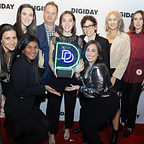“Ok, Boomer” — Heritage Brands are Finally Waking Up
Will 2020 Continue the Trend of Transformation for these Sleeping Giants?
Late last year, the phrase “Ok, Boomer” skyrocketed to popularity as both a call-to-arms for young people and a deliberate affront to their parents’ generation. Beneath the surface lays years of frustration by a younger generation that feels stymied by change-resistant elders. It is not unlike what’s been happening with heritage brands for the past many years.
“Innovation is not my job, Paul,” he said to me. It was 2012 and I was sitting across the table from a brand manager in Hershey, PA. My aim was to convince him to invest in social media — many years after most brand managers had already done so. “The brand is sacred,” he continued. “My job is to not screw it up…”
If only the phrase, “Ok, Boomer” had been available to me in that moment.
In the early days of social media, there were plenty of brands who jumped wholeheartedly into new innovations. However, the public offering of Facebook in 2012 shut the door on the perceived free-ness of social media, somewhat paradoxically leading many brands to regress. In particular, heritage brands seemed to re-entrench, focusing their resources on fewer, more traditional endeavours, like advertising.
From a short term perspective, it’s hard to blame them. Heritage brands have always enjoyed remarkable levels of awareness, purchase intent, and brand loyalty. It made sense to focus on low effort / high scale marketing channels. As the Reese’s brand manager once told me, “all I have to do is show people the color orange and it increases their likelihood to buy a Reese’s.” If you looked at the research, she was right. But, that confidence also created market conditions for disruption.
When the disruption came, it was swift and fierce. Unlike earlier disruptions from things like social media and mobile phones, which mainly shifted the PLACES that brands reached consumers, this new wave of disruption was systemic and business-impacting. The rise of DTC and digitally-born brands exposed a whole generation of consumers who were unhappy with how heritage brands marketed at them. The scale of these new DTC brands — often termed “piranhas” due to their overwhelming atomization, took major brand conglomerates by surprise.
As recently as 2016, the differences between heritage brands and their upstart challengers could not have been more stark. Heritage brands relied on old guard advertising agencies for strategy and “big ideas” while things like public relations and social media were low priorities. Influencers were treated like paid media inventory and product innovations were viewed as risky investments that often took years to come to market. DTC brands, on the other hand, led strategy internally and focused their paid media on performance marketing with modest spends and big ROIs. They leaned heavily on earned and social media and partnered with influencers as creators. Meanwhile, product innovations were treated as marketing strategies in and of themselves.
Today, the playing field is leveling. DTC brands are experimenting with brand building and physical storefronts while heritage brands are re-prioritizing PR and social media. The most pronounced renaissance for heritage brands has occurred in the food and beverage sectors. Heritage brands that were built on advertising like Domino’s, KFC, Bud Lite, Popeye’s, Reese’s, Taco Bell, and Heinz have captured the industry’s attention with marketing efforts that prioritized talkability and share-worthiness over old school creative.
Thankfully, all indications are that 2020 will be a year of continued transformation for heritage brands. In particular, heritage drugstore brands seem to be foretelling a brand marketing renaissance similar to what we’ve seen in food and beverage. RFP’s issued across the OTC heritage brand landscape are seeking greater relevance with young audiences, a focus on earned media, branded content, experiential activations, and influencer marketing. Category leaders like Excedrin and Mucinex* have also created a precedent that will make it easier for others to follow in the risk averse consumer health aisle.
All of this leads one to wonder whether 2020 will see the remaining bastions of old school advertising — personal care, automotive, telecom, insurance, financial services, and even (gasp!) pharmaceuticals, undergo a similar renaissance. For emerging brand leaders who grew up with social media, it’s hard to imagine them having the same reticence to ditching old models. However, for brands that have survived and grown for decades, it can be easy to dismiss trending tactics as fad-ish.
The question is, have these brands felt the impact of their reticence in their P&L yet. Because as soon as they do, the “Ok Boomer” decision makers are likely to be replaced with more modern-minded marketers.
If you’re reading this and wondering whether your brand fits in the innovator column or the “Ok, Boomer” column, there are a few telltale signs to look for.
The good news is, even if you’re an “Ok, Boomer” brand today, there are plenty of examples where sleepy brands have reinvented themselves. Consumers reward the brands that take them seriously and engage on their terms as long as it feels authentic and not pandering. 2020 is upon us, let it be the year that heritage brands continue to surprise and delight us.
* Mucinex is a Lippe Taylor client.
